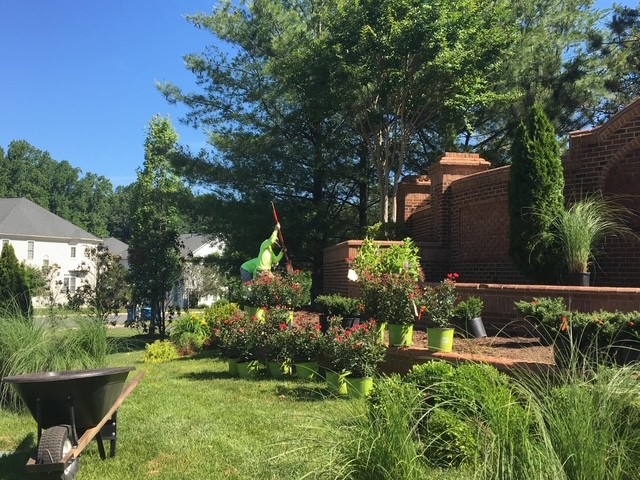WC Landscape delivers specialized lawn dethatching services throughout Centreville, VA, designed to eliminate the suffocating layer of dead grass and organic debris that builds up between your soil and living grass. This thatch layer, when exceeding 1/2 inch in thickness, restricts water penetration, blocks nutrients, and creates the perfect environment for lawn diseases and pests. Our professional dethatching services use commercial-grade equipment to effectively remove this barrier, instantly improving your lawn's ability to breathe, absorb water, and process nutrients.
Centreville's climate creates ideal conditions for thatch accumulation, particularly in lawns with cool-season grasses like tall fescue and Kentucky bluegrass. Our dethatching services are specifically calibrated for Centreville's soil conditions and grass varieties, ensuring maximum thatch removal without damaging healthy turf. Whether you're dealing with brown patches, water runoff issues, or simply want to enhance your lawn's overall health and appearance, WC Landscape's professional dethatching services provide the precise intervention your lawn needs to thrive throughout the growing season.



Our dethatching specialists employ advanced techniques and commercial-grade equipment to effectively remove accumulated thatch without harming your healthy grass:
Our approach focuses on thorough thatch removal while minimizing stress to your existing turf. We adjust our equipment settings based on your specific grass type, thatch thickness, and lawn conditions to ensure the best possible outcome for your Centreville property.
Timing is critical for successful dethatching. Our service schedules are optimized for Centreville's climate patterns and your specific grass type:
We work with you to identify the ideal dethatching window for your specific lawn conditions, ensuring maximum effectiveness with minimal recovery time.
Effective thatch control extends beyond just removal. Our complete thatch management program includes:
This holistic approach addresses both immediate thatch removal needs and long-term prevention, creating sustainable lawn health improvements.
WC Landscape invests in professional-grade dethatching equipment specifically designed for maximum effectiveness:
Our equipment allows for precise control over dethatching depth and intensity, ensuring we remove maximum thatch while minimizing stress to healthy grass plants.
Not all lawns need dethatching, and improper dethatching can damage healthy turf. Our specialists conduct thorough evaluations to determine if dethatching will benefit your lawn:
We recognize that every Centreville property has unique characteristics affecting thatch development and removal:
We view dethatching as one component of overall lawn health, integrating this service with complementary treatments:
Beyond removal, we provide valuable guidance on preventing excessive thatch buildup:
Thatch issues can manifest in several ways across Centreville lawns. Our specialists are trained to identify the signs of problematic thatch:
Early identification allows for timely intervention before thatch causes significant lawn damage or decline.
Severely thatched lawns require specialized approaches to restore health:
Our graduated approach ensures appropriate intensity based on your lawn's specific thatch severity.
Proper recovery care is essential after dethatching to maximize benefits:
This comprehensive recovery program ensures your lawn bounces back quickly from the temporary stress of dethatching, maximizing long-term benefits.
Many Centreville lawns suffer from both thatch and soil compaction, requiring an integrated approach:
This integrated approach addresses multiple soil barriers simultaneously, creating dramatic improvements in lawn health and appearance.
We begin with a thorough evaluation of your lawn's condition:
This detailed analysis ensures dethatching is appropriate for your specific lawn conditions.
With a team of 50 skilled professionals and over 40 years of combined experience, we deliver high-quality, customized landscaping solutions designed to improve both the beauty and functionality of your property.
Thatch is a layer of dead and decomposing grass stems, roots, and debris that accumulates between the soil surface and the green vegetation of your lawn:
These problems compound over time, making thatch management essential for long-term lawn health in Centreville.
Professional dethatching relies on scientific principles to maximize effectiveness:
This scientific approach delivers more effective results than aggressive raking or improper power equipment use, ensuring maximum benefit with minimal lawn damage.
Not all lawns benefit from mechanical dethatching. Understanding when to dethatch is critical:
With a team of 50 skilled professionals and over 40 years of combined experience, we deliver high-quality, customized landscaping solutions designed to improve both the beauty and functionality of your property.
Fall offers ideal conditions for dethatching Centreville's cool-season lawns:
While spring dethatching can be effective, the narrower recovery window before summer stress makes it a secondary choice when fall dethatching is possible.
Summer dethatching carries significant risks for cool-season lawns in Centreville:
WC Landscape generally recommends against summer dethatching for Centreville's predominantly cool-season lawns unless specific circumstances necessitate immediate intervention.
While active dethatching is not performed in winter, it's an important planning season:
Several indicators suggest your Centreville lawn may benefit from professional dethatching:
Visual and Tactile Signs:
Measurement Confirmation:
WC Landscape offers complimentary thatch assessments for Centreville homeowners, providing professional evaluation of your lawn's specific conditions.
While both services improve soil access, they address different lawn problems:
Dethatching:
Core Aeration:
Complementary Benefits:
Many Centreville lawns benefit from both services, with dethatching addressing surface barriers and aeration resolving subsurface compaction.
Professional dethatching causes temporary stress but delivers long-term benefits when properly performed:
Short-Term Effects:
Minimizing Damage Factors:
Recovery Expectations:
WC Landscape's professional approach minimizes lawn stress while maximizing thatch removal effectiveness, ensuring your Centreville lawn recovers quickly with proper post-treatment care.
Dethatching frequency depends on several factors specific to your lawn:
For Most Centreville Lawns:
Factors Affecting Frequency:
WC Landscape recommends regular thatch monitoring rather than fixed schedules, performing dethatching only when measurements indicate it's truly needed for your specific lawn conditions.
Several maintenance approaches help minimize thatch accumulation between dethatching services:
Mowing Practices:
Fertilization Strategies:
Biological Enhancement:
Irrigation Management:
WC Landscape provides comprehensive lawn care programs that naturally minimize thatch accumulation through these best practices, reducing the frequency of mechanical dethatching requirements.
Proper post-dethatching care maximizes recovery speed and service benefits:
Immediate Care (First 48 Hours):
Short-Term Recovery (First 2 Weeks):
Long-Term Enhancement (First 2 Months):
WC Landscape provides detailed after-care instructions specific to your lawn's conditions, ensuring maximum benefit from your dethatching investment.